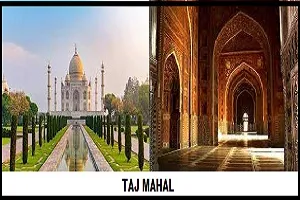The Taj Mahal, an unparalleled architectural masterpiece, stands as a symbol of eternal love and a wonder of the world. Located in Agra, India, the Taj Mahal has captured the attention of people from all corners of the globe for centuries. Built by Mughal Emperor Shah Jahan as a testament of love and homage to his beloved wife, Mumtaz Mahal, the Taj Mahal has become one of the most iconic landmarks in the world.
History of the Taj Mahal
The Taj Mahal was constructed between 1631 and 1653 AD by over 20,000 skilled workers led by chief architect Ustad Ahmad Lahauri. Shah Jahan, born as Khurram, inspired the construction of this monument following the tragic death of Mumtaz Mahal during childbirth. According to legend, at the time of her death, Mumtaz Mahal requested that Shah Jahan build a beautiful mausoleum as a symbol of their eternal love.
Architecture of the Taj Mahal
The Taj Mahal is a perfect blend of Persian, Mughal, and Indian architectural styles. The building is made of beautiful white marble adorned with intricate carvings and inlays. Towering minarets standing at 40 meters grace the corners of the structure, while the large central dome exhibits stunning beauty.
One of the most striking features of the Taj Mahal's architecture is its perfect symmetry that adorns every aspect. Every detail, from the placement of doors and windows to the beautiful gardens, was meticulously thought out to create perfect harmony.
Meaning and Beauty
The Taj Mahal is not merely a historic structure; it is a symbol of eternal love. Shah Jahan constructed the Taj Mahal as the final resting place for Mumtaz Mahal, where the two are now united in eternal peace. The beauty of the Taj Mahal lies not only in its stunning architecture but also in the meaning it holds within.
Furthermore, the Taj Mahal stands as a silent witness to the grandeur of the Mughal Empire in times past. With its mesmerizing beauty and rich history, the Taj Mahal has become a major attraction for millions of visitors each year.
World Heritage Site
In 1983, UNESCO recognized the Taj Mahal as a World Heritage Site, acknowledging its significance to the global cultural heritage. This step reinforces the importance of preserving and conserving the Taj Mahal for future generations.
Tourism and Visitors
Every year, millions of people from around the world visit the Taj Mahal to witness this wonder firsthand. Tourists from various countries come to admire the architectural beauty, feel the aura of love in the air, and capture unforgettable moments through photographs.
Facts About the Taj Mahal
1. Construction
The Taj Mahal was built between 1631 and 1653 by Mughal Emperor Shah Jahan as a mausoleum for his wife, Mumtaz Mahal.
2. Architecture
The building is made of beautiful white marble with intricate carvings and inlays, creating perfect symmetry.
3. Symbol of Love
Taj Mahal is considered a symbol of eternal love, where Mumtaz Mahal is entombed, and now stands as one of the most romantic places in the world.
4. UNESCO World Heritage
Recognized as a UNESCO World Heritage Site in 1983, affirming its invaluable cultural and historical significance.
5. Tourist Visits
Every year, millions of tourists from around the world visit the Taj Mahal to witness its breathtaking beauty and learn the story behind its construction.
Conclusion
The Taj Mahal is more than just a structure of stone and marble; it is a symbol of eternal love, breathtaking beauty, and an invaluable historical heritage. As time passes, this wonder continues to stand as a testament to human greatness and undying love. In the shadow of the Taj Mahal, we are reminded of eternal beauty and the unbeatable power of love.
That is the article entitled Eternal Beauty: Taj Mahal. If there are any deficiencies or errors in writing this article, the Pustaka Pengetahuan expresses its deepest apologies. Please leave a wise message in the comments column provided. Thank you for visiting, hopefully it's useful.
Other reading materials, can help with school assignments, click Berbagai Reviews
To increase insight and knowledge, please click Baraja Farm
For tutorial on how to cultivate, please click Baraja Farm Channel
Social media please click facebook

Tidak ada komentar:
Posting Komentar